One of the fascinating outcomes of Options occurs when you learn how to mix and match either calls or puts with one another to take advantage of strike prices and premiums to create risk profiles which are extremely advantageous. Mastery of this skill does require some initial effort, but it’s well worth it.
Options favor those who are arithmetically inclined, but you don’t need to be a math whiz to succeed with them. All that is required in Options trading is to have a very firm understanding of where the risk “is” and where the reward begins.
Today, we are going to look at a strategy referred to as the Calendar spread. A calendar spread is the combination of a long option in a further dated expiration with the simultaneous combination of selling that same strike price and same option in a near term expiration. This concept is extremely easy to understand when you break it down to its simplest components.
The risk profile of purchasing a call option ALWAYS looks like this:
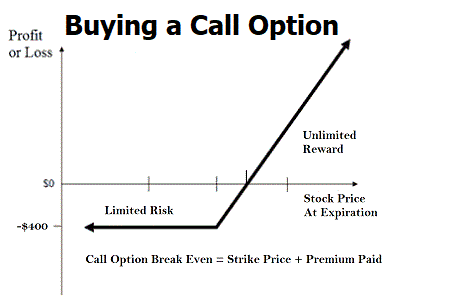
Call option buyers have limited risk in they can only lose the premium they paid for the option. They also have unlimited reward possibilities if the stock which represents the underlying asset makes a huge move to the upside.
On the other hand, Call option sellers are the creators of the option. Their risk profiles will always look like this:
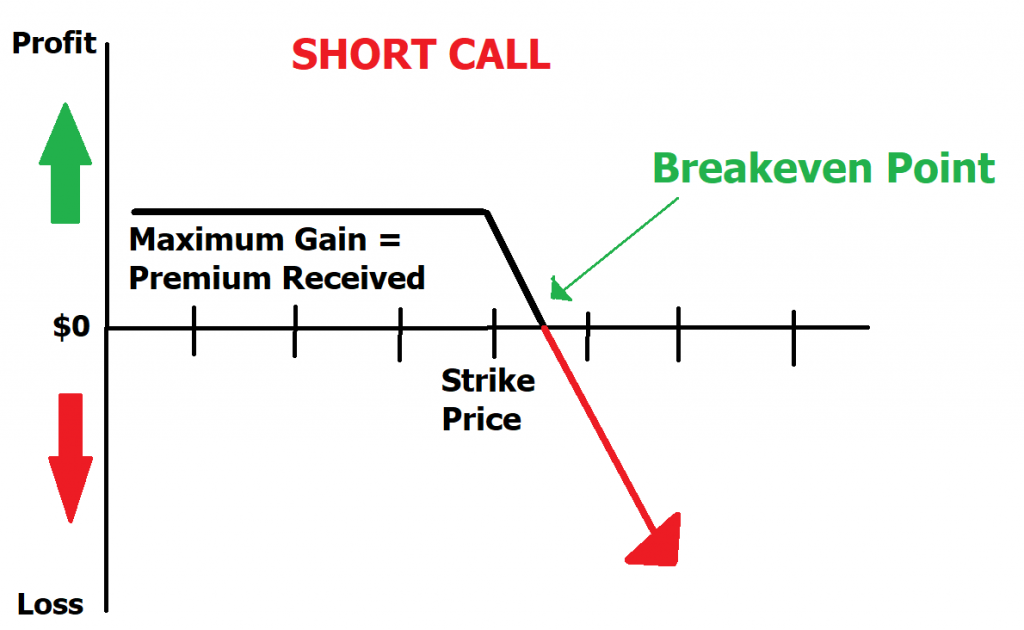
The most amount of money that a call option seller can make is the premium they receive. Theoretically, they have unlimited risk because the stock could go to infinity.
The reality is all options traders must deal with the reality that options are finite trading instruments which remain valid only until the options expiration date. This means an option is a deteriorating asset. With all things being equal, the option will be worth less tomorrow than it is today. Graphically this can be represented by the following chart which represents the time decay of an option.
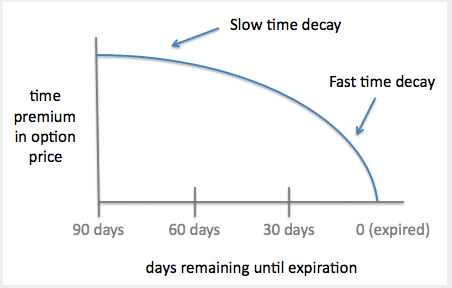
What the above graph demonstrates is how option premiums decay exponentially the closer we get to an options expiration date. When traders genuinely understand the time decay of an option, they quickly learn how to become SELLERS or creators of options, so that they can collect premium. But with this trading style comes a huge problem, that being that option sellers do not have limited risk. They have obligations that they must fulfill unless they offset their options trade before the expiration date.
By learning to combine the risk profiles of a LONG CALL and a SHORT CALL with similar strike prices but different expiration dates, options traders can exploit TIME DECAY with limited risk. This is one of the primary reasons for the existence of a calendar spread. In a typical calendar spread, one would buy a longer-term contract and go short a nearer-term option with the same strike price. If two different strike prices are used for each month, it is known as a diagonal spread.
Let’s explore this concept in very granular detail.
Let’s say, that a trader wants to buy the XYZ July 100 Call at $4.
By purchasing this call Option, they have the right but not the obligation to purchase XYZ at $100 per share between now and the Expiration in July.
July is a few months away so the trader who buys this call knows immediately that their break-even price is the strike price of $100 plus the premium of $4 paid for the option which equates to $104. But by looking at May Option Series they learn that they can simultaneously SELL the May $100 Call Option at 2.50. This obligates them to deliver XYZ stock between now and
the May Expiration at $100 a share. The most they can make on this leg is the premium they collect of $2.50.
At very first glance this trade may seem completely counterproductive. The trader is buying the right to own XYZ at $100 in July, but they are simultaneously obligating themselves to deliver XYZ in May at $100. How can you make any money if you have the right to buy XYZ at $100 and are obligating yourself to deliver XYZ at the exact same price?
The answer might surprise you. It all lies in the difference between option premiums.
Whenever you trade options, you are trading TIME. Buyers are giving themselves more opportunities for the price to move in their direction. The bottom line to this reasoning is that “TIME is Money” and the more time you buy, the more it is going to cost you. Calendar spreads are also known as ‘time spreads,’ ‘counter spreads,’ ‘horizontal spreads,’ ‘inter-delivery’ and ‘intra-market’ spreads. I also like to think of them as capturing time decay spreads for reasons which will quickly become obvious.
Whenever you combine the risk profiles of owning a distant call with being short a nearby call, this is what a calendar trade looks like:
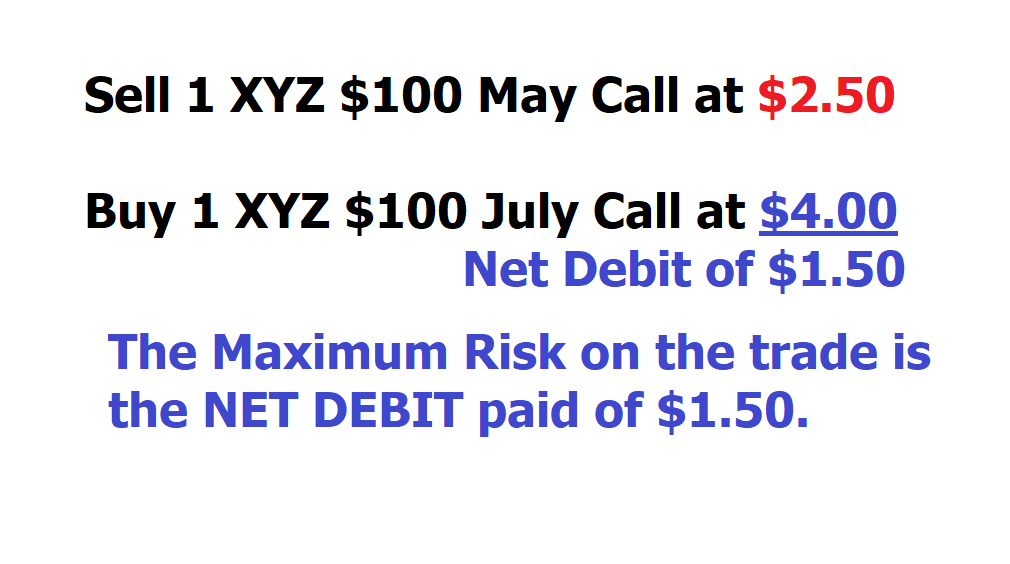
Note if the trader were to simply buy the July expiration, the cost would have been $400 dollars, but by employing this spread, the cost required to make and hold this trade was only $150, making the trade one of better margin and less risk.
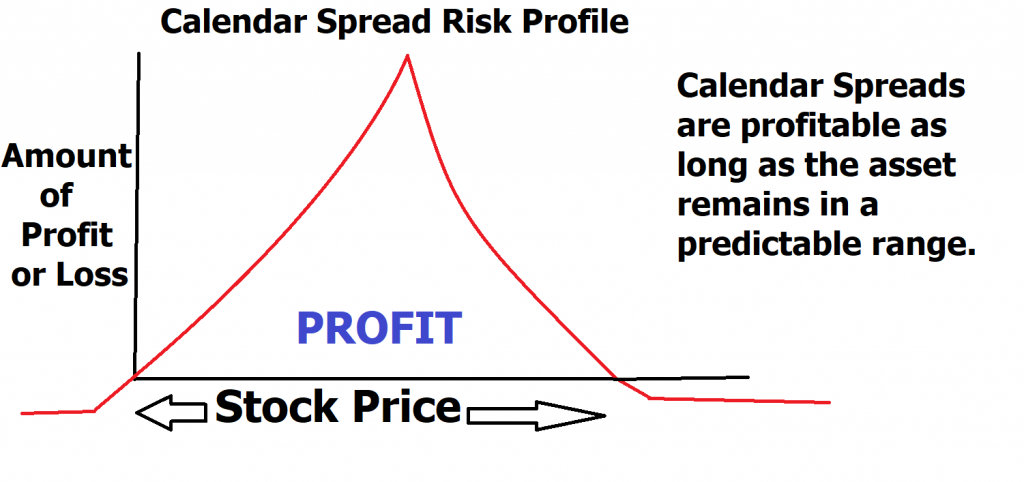
Since the strike prices are identical on this trade, we can quickly determine that the risk is whatever DEBIT amount was paid to put on this calendar spread. In this instance, it is $1.50 per share. But since we are dealing with options with two different expiration dates, we need to clarify this in greater detail to understand where the opportunity in this trade is. The purpose of the trade is to profit from the passage of time and/or to benefit from an increase in implied volatility in a directionally neutral strategy.
The May Option expiration is 4 weeks away.
The July Option Expiration is 12 weeks away.
This factor tells us that the May option premium of $2.50 will decay at a rate of .625 every week.
On the other hand, the July Option which has 12 weeks left to option expiration will decay at a rate of .333 per week. The difference in time decay is .292 which occurs primarily because the May Call Option expires faster than the July Call option.
A few caveats – I’m going to assume that prices remain completely flat so that we can compare apples with apples. Be forewarned prices hardly ever remain perfectly flat. This for illustrative and educational purposes only. We do not give trading advice.
What we know about this trade is that at any price under $100 at expiration all the options will expire worthless. Should this occur, the worst-case scenario would unfold which means that the trader would lose the net debit of $1.50 per share or $150.
If the price of the stock explodes much higher the worst-case scenario will also occur, and the loss of $1.50 per share will ensue.
Let’s assume that prices at the May expiration are slightly below $100. The trade after four weeks of time decay would look as follows:

The above table shows you the granular effects of time decay when prices remain below the $100 strike price. The May $100 call was losing value of .625 every week. The July $100 call since it is 8 weeks out further in expiration than May is only losing .333 per week.
After 4 weeks the calendar spread captured at total of $1.167 per share by simply playing the time decay aspect of options trading.
This may not seem exciting to the average trader. In all honesty, most of the time, calendar spreads are like watching paint dry. They are very boring but usually very predictable. We always know what the worst-case scenario is. But because of the two differing option expirations dates it is hard to calculate the best-case scenario.
Why?
Quite simply, the trader has choice as to what to do at the May Option expiration. If the May Option expires worthless, they have captured the entire premium that they were short. Now they must decide what to do with their July Option. They can hold. Or they can liquidate it.
If they choose to hold, they have 8 weeks until the July option expires. If the market moves sideways, they will lose the entire remaining value of the premium.
However, if the stock makes an explosive move higher after the May expiration, they theoretically have unlimited profit potential.
Also, it is only at the May Options expiration that we can realistically value what the value of the July call option might be based upon where the stock price is trading at that time.
It’s all about choice. The more choices you have in trading the more powerful of a position you have and that is why I behoove you to study Options trading very carefully. It could pay dividends because you can enter into strategies that are directionless and still profit, but nothing is guaranteed.
Whenever you trade a stock, the relationship between profit and loss is very black, white, and linear. But when you trade options the opportunity to put odds overwhelmingly in your favor exist because of aspects like time decay.
There are five potential outcomes in any trade:
- You make money if the stock goes up a lot
- You make money if the stock goes up a little
- You make money if the stock remains unchanged
- You make money if the stock goes down a little
- You make money if the stock goes down a lot
A skilled options traders can create a risk reward profile that benefits from most of the above possibilities on each trade they take. This is what makes options trading so exciting. This is why creating strategies which exploit time decay are worth your further study.
But we live in remarkably interesting times. Options trade going out as far as a year in advance. On most stocks, futures and even cryptocurrencies options often exist on quarterly expirations.
Today we have weekly options expirations on over 500 different stocks, ETF’s and indexes. In fact, options on the SPY Index expire three times a week.
The best and most effective way to learn more about how to capture time decay in a risk managed fashion is to practice in a demo account with your broker. Popular stocks that have weekly options include, AAPL, ADBE, AMZN, DBX, FB, GOOG, JNJ, NVDA, QCOM and YHOO. Heavily traded index ETFs with weekly options include DIA, IWM, QQQ and SPY.
Bookmark this article and check back here shortly and we will provide you with an entire listing of all weekly option expirations.
Intrigued? We explore these kinds of trading ideas on your Live A.I. Trading Masterclass which is free to attend.
When stocks have Options which expire every week, understanding the mechanics of this strategy are vital towards creating tactics that continue to put the odds in your favor while simultaneously creating income in your portfolio.
But here is where things can get really exciting. Imagine using Artificial Intelligence to put the odds even further in your favor!
How?
Vantagepoint forecasts trend direction up to 3 days in advance with up to 87.4% proven accuracy!
Great trading is never about how much you make when you are right. It’s always about how little you lose when you are wrong. When you learn how to sell Options and collect premium you can actually be wrong and potentially profit. I just described this tactic in the example above.
Everybody has had horrible trades. The difference between the winners and losers in life is that the winners learned immensely powerful lessons from their losses.
Artificial intelligence is so powerful because it learns what doesn’t work, remembers it, and then focuses on other paths to find a solution. This is the Feedback Loop that is responsible for building the fortunes of every successful trader I know.
Artificial Intelligence applies the mistake prevention as a continual process 24 hours a day, 365 days a year towards whatever problem it is looking to solve.
That should get you pretty excited because it is a game-changer.
Find the trend.
Scrutinize the 1–3-day forecast.
Lather. Rinse. Repeat.
The answer AI offers may surprise you.
This is how small traders grow their accounts by taking small bites out of the market consistently.
Today Artificial Intelligence, Machine Learning and Neural Networks are an absolute necessity in protecting your portfolio.
I, like everybody else, have my opinions about what will happen next. But I never let my opinion get in the way of what the artificial intelligence is forecasting.
While reporters, talking heads and analysts want to discuss esoteric economic ideas, my only loyalty as a trader is to the trend! This is how Vantagepoint artificial intelligence simplifies and empowers traders daily!
Intrigued? Visit with us and check out the a.i. at our Next Live Training.
We’ll show you at least three stocks that have been identified by the A.I. that are poised for big movement
Discover why artificial intelligence is the solution professional traders go-to for less risk, more rewards, and guaranteed peace of mind.
It’s not magic. It’s machine learning.
Make it count!
THERE IS A SUBSTANTIAL RISK OF LOSS ASSOCIATED WITH TRADING. ONLY RISK CAPITAL SHOULD BE USED TO TRADE. TRADING STOCKS, FUTURES, OPTIONS, FOREX, AND ETFs IS NOT SUITABLE FOR EVERYONE.IMPORTANT NOTICE!
DISCLAIMER: STOCKS, FUTURES, OPTIONS, ETFs AND CURRENCY TRADING ALL HAVE LARGE POTENTIAL REWARDS, BUT THEY ALSO HAVE LARGE POTENTIAL RISK. YOU MUST BE AWARE OF THE RISKS AND BE WILLING TO ACCEPT THEM IN ORDER TO INVEST IN THESE MARKETS. DON’T TRADE WITH MONEY YOU CAN’T AFFORD TO LOSE. THIS ARTICLE AND WEBSITE IS NEITHER A SOLICITATION NOR AN OFFER TO BUY/SELL FUTURES, OPTIONS, STOCKS, OR CURRENCIES. NO REPRESENTATION IS BEING MADE THAT ANY ACCOUNT WILL OR IS LIKELY TO ACHIEVE PROFITS OR LOSSES SIMILAR TO THOSE DISCUSSED ON THIS ARTICLE OR WEBSITE. THE PAST PERFORMANCE OF ANY TRADING SYSTEM OR METHODOLOGY IS NOT NECESSARILY INDICATIVE OF FUTURE RESULTS. CFTC RULE 4.41 – HYPOTHETICAL OR SIMULATED PERFORMANCE RESULTS HAVE CERTAIN LIMITATIONS. UNLIKE AN ACTUAL PERFORMANCE RECORD, SIMULATED RESULTS DO NOT REPRESENT ACTUAL TRADING. ALSO, SINCE THE TRADES HAVE NOT BEEN EXECUTED, THE RESULTS MAY HAVE UNDER-OR-OVER COMPENSATED FOR THE IMPACT, IF ANY, OF CERTAIN MARKET FACTORS, SUCH AS LACK OF LIQUIDITY. SIMULATED TRADING PROGRAMS IN GENERAL ARE ALSO SUBJECT TO THE FACT THAT THEY ARE DESIGNED WITH THE BENEFIT OF HINDSIGHT. NO REPRESENTATION IS BEING MADE THAT ANY ACCOUNT WILL OR IS LIKELY TO ACHIEVE PROFIT OR LOSSES SIMILAR TO THOSE SHOWN.







